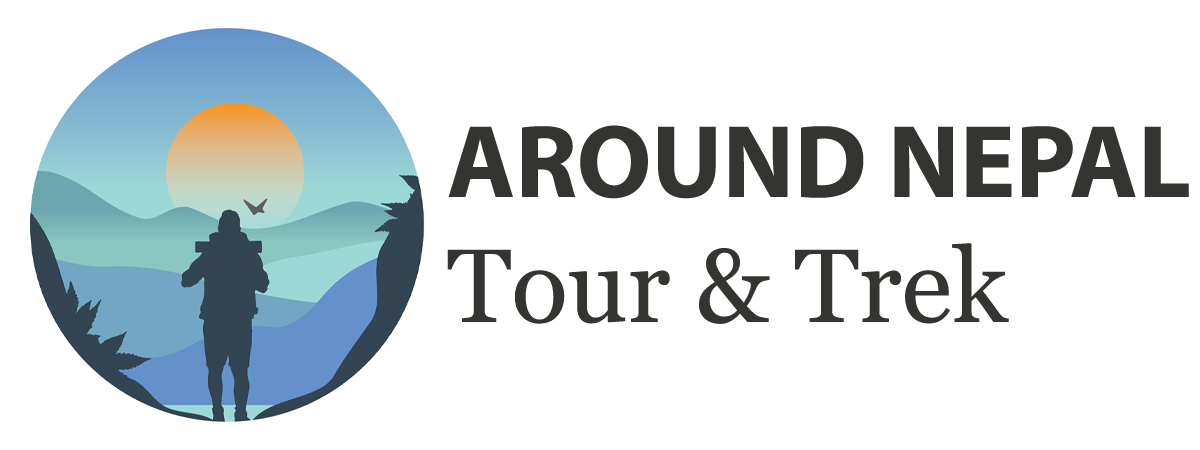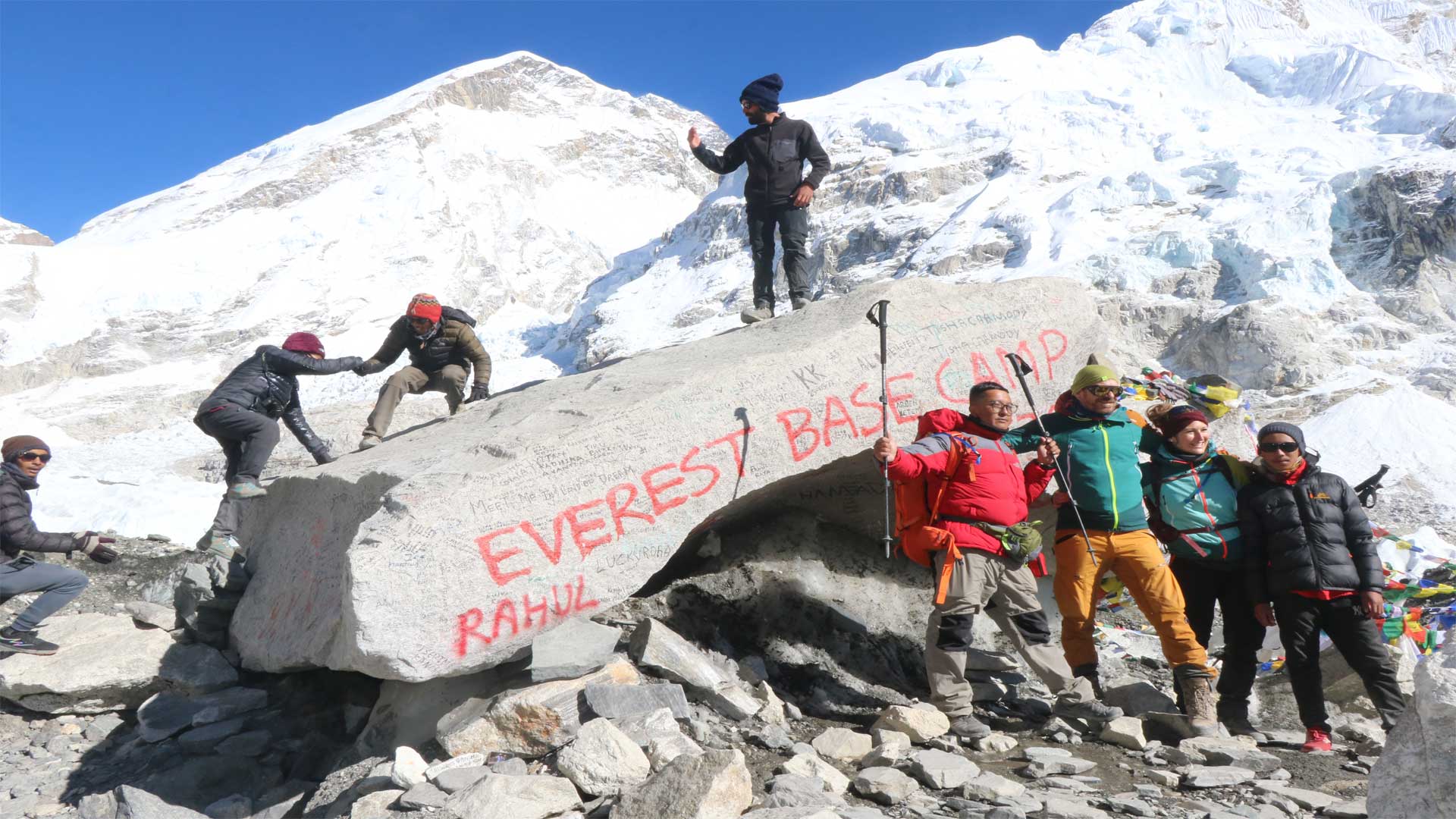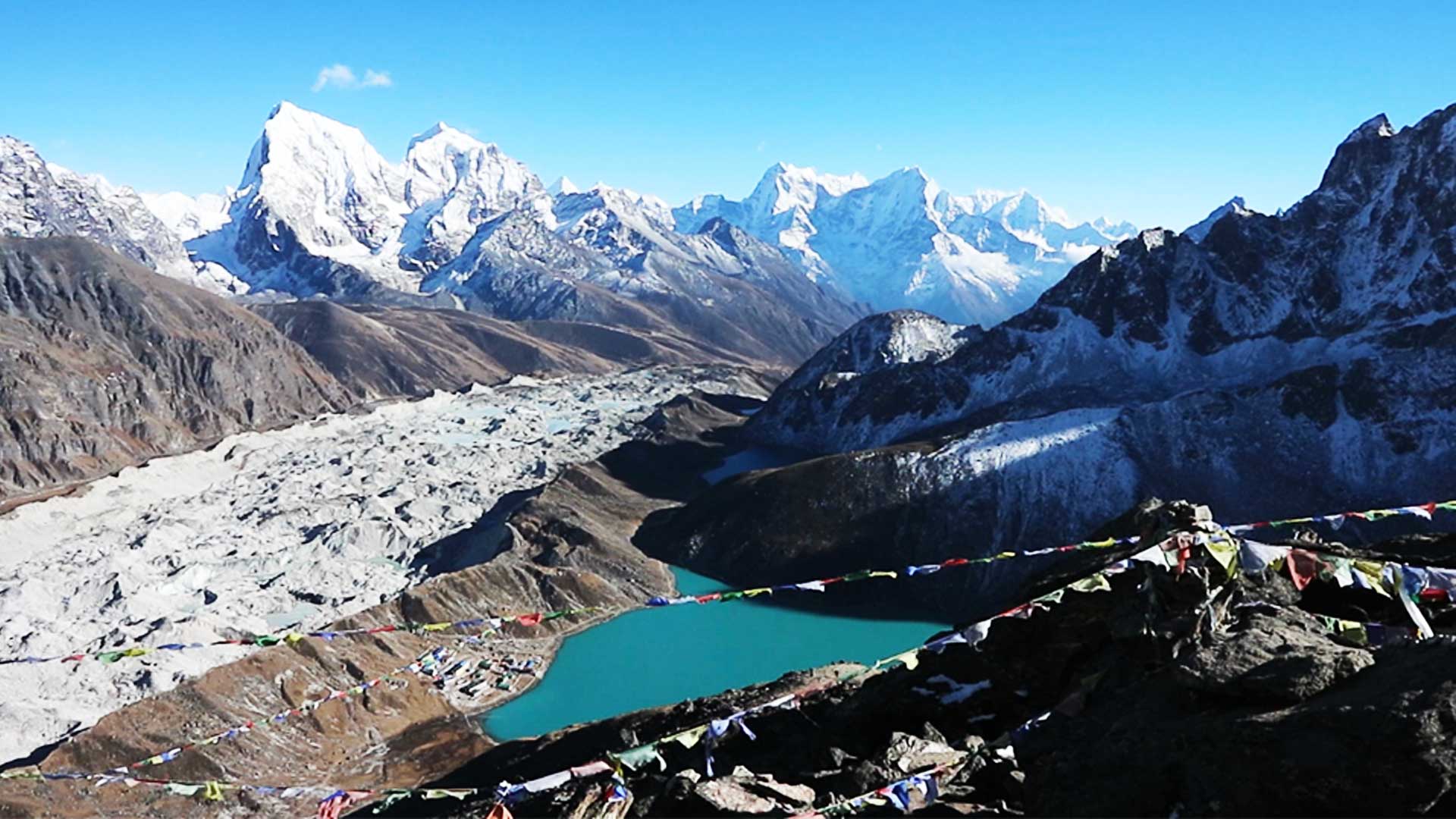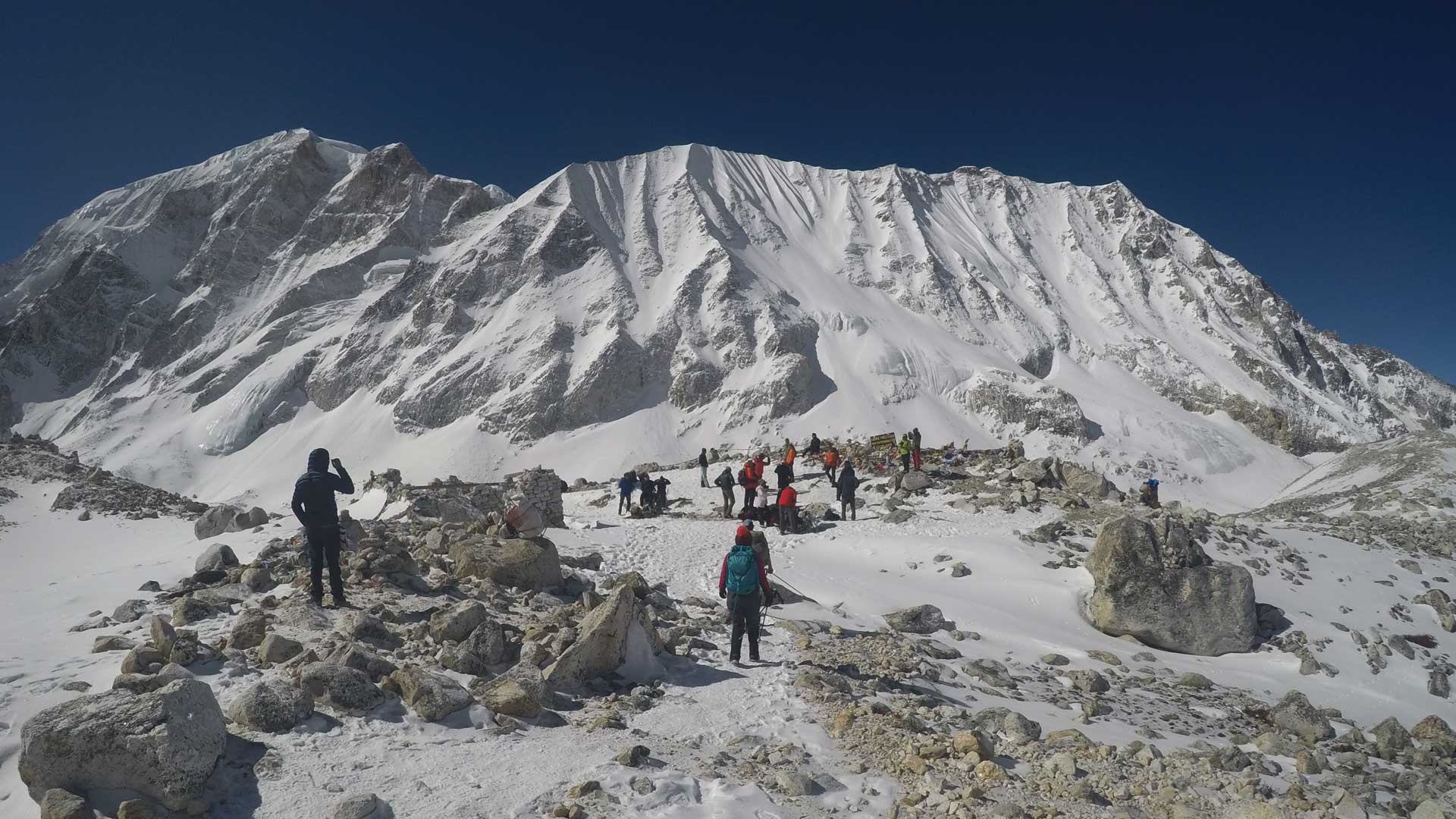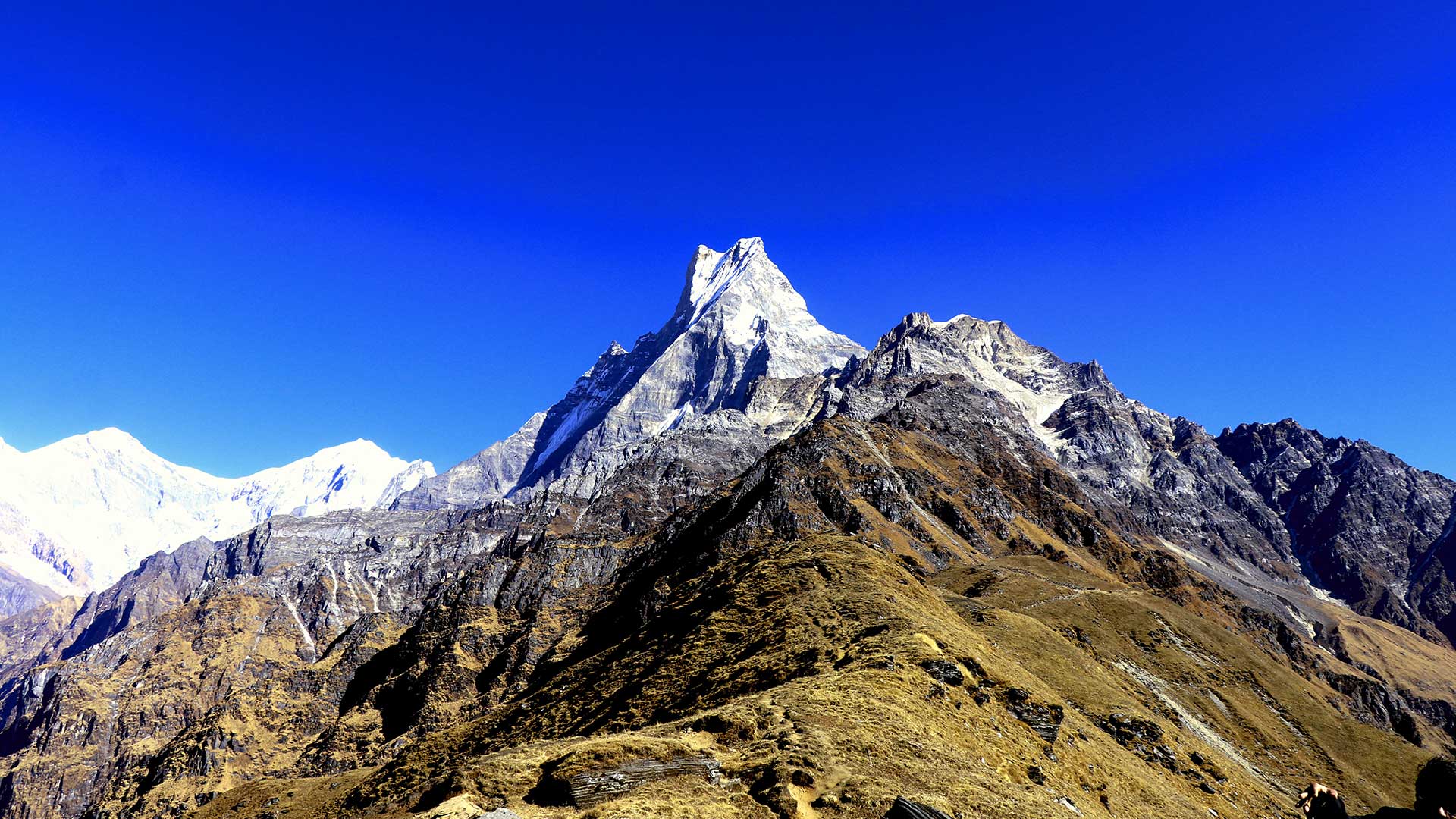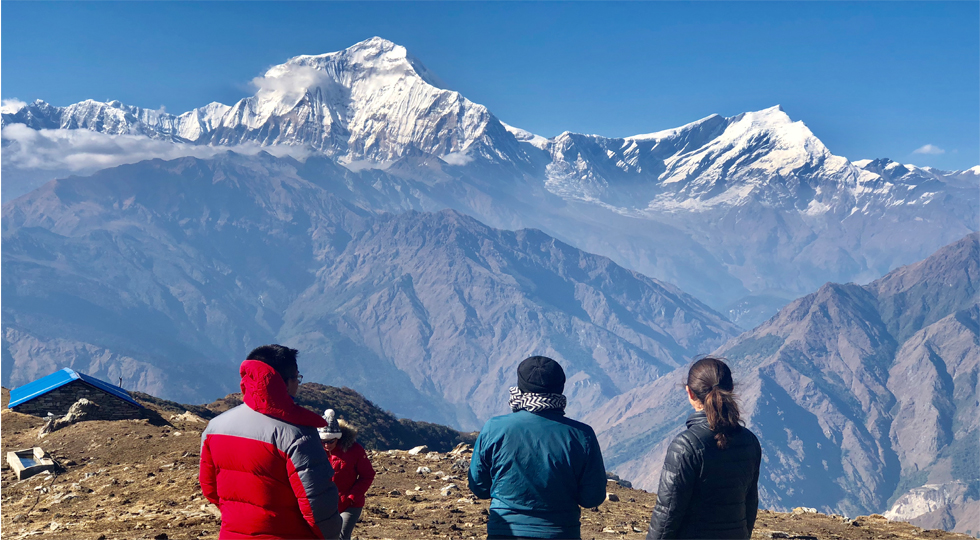Annapurna Circuit Trek
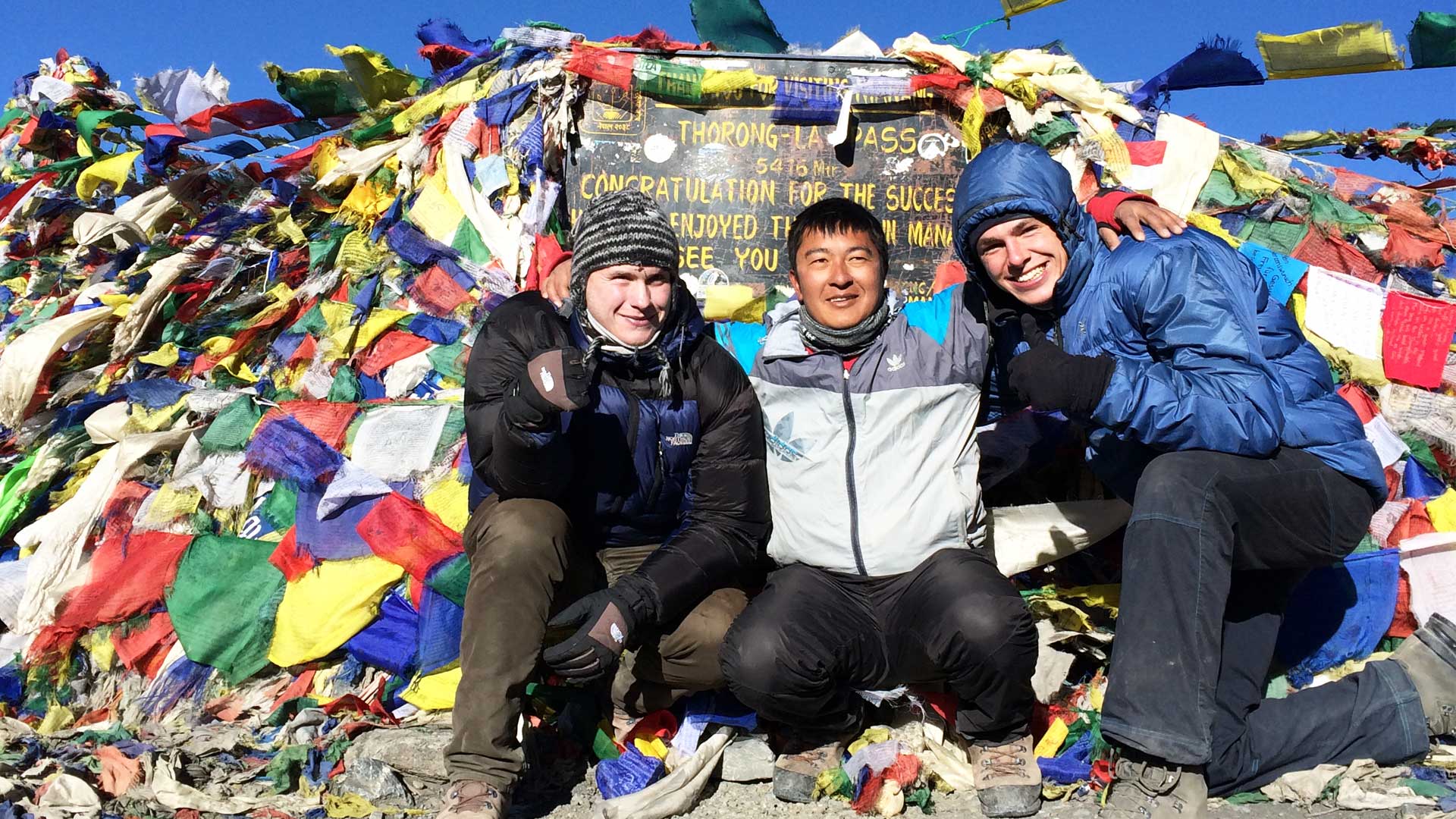
14 days
5,416 meters,
Spring & Autumn
hotel, tea-house
TRIP HIGHLIGHTS
- The stunnig close view of three mountains over 8,000m of Annapurna range: Dhaulagiri (8,167m), Manaslu (8,163m), Annapurna I (8,091.
- Numerous eye-catching peaks ranging in height from 6,000 to 8,000 meters: Annapurna II (7,937m), Dhaulagiri II (7,751 m), Gangapurna (7,455m), Tilicho Peak (7,134m), and other numerous peak between the 6000m to 8000m.
- The different variant climate zone such as tropical hot low land to the arctic cold high pass Thorung Pass/Thorong Pass (5,416m).
- Follow a pair of lake valleys Kathmandu Valley (1,400m) and Pokhara Valley (822m), a pair of the world’s deepest river valleys Kali Giandki River Valley and the Marsyangdi River Valley.
- Taking a one week more to explore the inner Annapurna circuit Nar and Phu valley which is the real off-the-beaten path for observing the Tibetan culture and religion.
- The old century pilgrimages such as Bhraka/Bagra Monastery and The MuktinathTemple (3,710m), a sacred site for both Hindus and Buddhists, a beautiful example of religious harmony.
- The 7,629-square-kilometer Annapurna Conservation Area, with an altitude range of 790 to 8,091 meters.
- Popular Poonhill View Point (3,210m) to overlook the Dhaulagiri Mountain Range and the Annapurna Massif Range.
- Several waterfalls: Rupse Chhahara Waterfall (about 300 meters high) Dhampus Waterfall (70 meters high),Tal waterfall about 60 meters high), Dharapani Waterfall (about 30 meters), hot Water Spring/Natural Tatopani Springs (1,190m), it is believed in medical properties for arthritis, skin diseases etc.
- Explore a mountain range, Fewa Lake, David waterfall, Mahendra cave, etc from Pokhara City (822m), the world’s highest Lake, Tilicho-Lake (4,919m), Ice Lake/Kicho Lake (4,620m), Gangapurna Lake in Manang.
- The popular dventurous activities for boating, paragliding, rafting, bungee jump, cannoning, mountain flight etc.
- Flora: Nepal’s national flower Rhododendron, apple orchard, gardens, oak, pine, juniper, bamboo, alpine flower etc.; and fauna: blue sheep, pika, pheasant, himalayan pigeon, snow leopard, yak, langur monkey, musk deeer, Himalayan tahr, chyangra Goat etc.
TRIP OVERVIEW
The Annapurna Circuit Trek is a popular Himalayan trek in Nepal's central region. It is one of the world's best world-class trekking destinations. This trek is located in Nepal's central zone, in the western part of the main city Kathmandu Valley. The total length of your trek is determined by your means of transport. Its length could be as little as 155m and as much as 235m. Along the way, you can witness stunning views of Annapurna massif, Dhaulagiri, Machhapuchhre (Fishtail), other peaks and two distinct lake valleys and two river valleys, a variety of landscapes, rivers, lakes, streams, waterfalls, as well as the local culture and tradition of the diverse ethnic communities and so on. This trek also takes you from the lowland subtropical forest to the highest mountain point in the Himalaya Region, Thorungla La Pass, at an elevation of 5,416 meters (17,769 feet), as well as the massive Tibetan plateau, which covers an area of 2,500,000 square kilometers. To make this trek easier and safer, most trekkers take the clockwise route.
Annapurna Circuit Trek is a clockwise trek that begins after a 7-9 hour Jeep ride from Kathmandu to Dharapani on the Trishuli River and Marshangdi river banks in Lamjung district (Dharapani is the joining places after the Manaslu Circuit Trek). The route pass through beautiful Himalayan villages, particularly Manang valley, with views of massive mountain peaks, the rushing Marshyangdi River, apple orchards, and highland farming places at various altitudes. The trail leads you above Manang to a nearby view point of massive Himalayan vistas. You attempt the highest point Thorung-la pass (5,416m), where you touch the snow and frost, take some memorable photos and videos around the top, and descend to the Kaligandaki river bank at Mustang valley. Mustang is well-known for its religious Muktinath Temple, which attracts both Hindu and Buddhist pilgrims. On the way down to Muktinath, you can see Mount Dhaulagiri and Tukuche peak. Mt. Dhaulagiri is the world's seventh highest peak. You arrive in Jomsom after a day trip from Muktinath and fly back to Pokhara the next morning. Jomsom is the district headquarters of Mustang and is also accessible by ground transportation.
The Annapurna Circuit is a high route trekking trail that runs in a circle. It is the ideal holiday trail for all hikers who want to experience a variety of climates, but it is physically and mentally demanding. It necessitates excellent physical fitness as well as a calm mental attitude. We do not recommend this trek for people over the age of 70 or children under the age of 15. This trek is also not suitable for those who are suffering from heart disease, respiratory problems, neurosis, bathing, or who have been accidentally deep injured.
The Annapurna Circuit can be trekked all year, but the best seasons are March to June, September to November, and Mid-December because of the pleasant temperatures, good weather, and good visibility.
Note: If you want to visit the remote but real world's off-the-beaten-path Nar Phu valley trek, it takes a week longer and separates from Koto; join it at Ngawal village near Manang after attempting the difficult Kangla pass (5,306m). This route is very remote and less traveled, but it preserves the true value of the remote Himalayan people's lifestyle, particularly Tibetan culture and religion. This trail is also well-known for the Himalayan Viagra Yarsha Gumba, the most expensive herbal medicine in the world, which can be obtained by hiking to Himlung base camp. Himlung peak is the best peak to climb in the Annapurna region for gaining excellent climbing experience and experiencing the adventure of challenging mountains and peaks. In addition, the Nar Phu valley is well known for its yak and sheep grassland. If you want to join this restricted trekking route, you must pay a special entrance fee of US$90 per person, which is collected by the Immigration of Nepal in Kathmandu.
SHORT ITINERARY
Day 1: Arrival in Tribhuwan International Airport, Kathmandu (1,400 meters)
Day 2: Sightseeing around Kathmandu Valley
Day 3: Drive from Kathmandu to Dharapani (1,960meters) (7-8 hours)
Day 4: Trek from Dharapani to Chame (2,650 meters) (6-7 hours)
Day 5: Trek from Chame to Pisang (3,300 meters) (5-6 hours)
Trek 6: Trek from Pisang to Manang (3,570 meters) (5-6 hours)
Day 7: Acclimatization Day at Manang (7-8 hours)
Day 8: Trek from Manang to Yak Kharka (4,120 meters) or Churi Leder (4-5 hours)
Day 9: Trek from Yak Kharka to Base Camp and High camp on Thorong Phedi (4,450m) (4-5 hours)
Day 10: Trek from Thorong Phedi to Muktinath (3,800 meters) via Thorong la Pass or Thorung la Pass (5,416meter) (6-7days)
Day 11: Trek from Muktinath to Jomsom (2,750m) through Kagbeni (6-7 days)
Day 12: Fly from Jomsom to Pokhara (822 meters) (20 minutes)
Day 13: Drive from Pokhara to Kathmandu (1,350 meters) (6-7 hours) Or Fly from Pokhara to Kathmandu (30 minutes)
Day 14: Departure
Season of Annapurna Circuit Trek
The ideal times to trek the Annapurna Circuit are in the spring and autumn. The best months of the year are September, October, and November in the autumn and March, April, and May in the spring. In contrast to other months, September, October, and November in the autumn season have clear skies and a clean environment. The months of February, March, and mid-April in the spring rovide warmer and longer days as well as excellent visibility. The best month for the Annapurna Circuit Trek is October, which is one of the best months. Because this route must attempt to enter the high peak Thorung La Pass (5,416m). The heavy snowfall in January may obstruct the hiking route. In comparison to the busy season of autumn, February, March, and early April are warmer, longer, and quieter. Rainfall also occurs in May during the early monsoon. In the area with low elevation, it is a scorching day. In the monsoon season, the months of June, July, and August might experience flooding, landslides, a lots of rain, and extremely hot days. Therefore, it is advised that Annapurna Circuit Trek should be avoided in January, February, late April, June, July, and August.
Annapurna Circuit Trekking Cost
The Annapurna Circuit Trek cost varies according to the services provided, the length of stay, and what is included and excluded. Our company charges $1,495 per person for 14-day programs that include three nights in a three-star hotel in Kathmandu with bed and breakfast, TIMS and permit cards for guests, ten breakfasts, nine lunches, and nine dinners with tea and coffee during the trek, one night in a one-star hotel in Pokhara with bed and breakfast, day sightseeing in Pokhara and the Kathmandu valley, and all ground and air transportation for guests and office staffs. We are sure that we will provide you with excellent services at a reasonable cost.
Physical fitness requirement for Annapurna Circuit Trek
The Annapurna Circuit Trek is generally considered to be a moderately challenging trek, but it is less tough than the Everest Base Camp Trek. Sickness is more common at high altitudes above 2500 m. A good level of physical condition is required for the Annapurna Circuit Trek since you must walk for 6 to 8 hours per day and travel from a low point of 800 meters in Pokhara to a high point of 5,416 meters at Thorung Pass. The ability to adjust to both thin air at high altitude and dense air at low altitude requires a medium level of fitness. So you need to have medium physical fitness to complete your journey. You are advised to take proper acclimatization measures and to be aware of the risks associated with high altitude trekking.
TIMS and Permit costs (permission fees) for the Annapurna Circuit Trek
The Annapurna Circuit Trek is part of the Annapurna Conservation Area Project. As a result, a permit card is required for entrance to the Annapurna Conservation Area. A permit costs NPR 2000 per person and a TIMS (Traveling Information management system) card costs NPR 1000.
Annapurna Circuit Trek Duration
The length of the Annapurna Circuit Trek is determined by your time, budget, and level of interest. Its overall length ranges from 160km to 230km and mostly cover the Manang and Mustang rain shadow zones. It takes a total of 14 days to travel from Dharapani to Jomsom. It takes 16 days to travel from Dharapani to Pokhara through Ghorepani Poon Hill. It takes three weeks to a month to extend your journey to join us at Annapurna Base Camp. We plan to start in Dharapani and end in Jomsom, then fly to Pokhara before driving to Kathmandu by tourist bus for 14 days itinerary.
Difficult level in Annapurna Circuit Trek
The Annapurna Circuit Trek is the toughest trekking route. This trek begins at 1,900 meters in Dharapani, Lamjung district, and ends at 2,745 meters in Jomsom, Mustang district. Every day, you should walk 6-8 hours up and down the rocky cliffs. Every day, the trail brings you very close to the mountains, but you also face the high-altitude challenge. As a result, this trek necessitates good physical fitness as well as mental preparation.
Food and Accommodation in Annapurna Circuit Trek
Similar to Everest Base Camp, the Annapurna Circuit Trek is a well-maintained teahouse trail. Food and accommodation are quite reasonably priced. There is a wide selection of food items. Noodles, spaghetti, spring rolls, potato items, a variety of egg items, and especially the potent Nepali meals Dal-Bhat are offered. You can get the menu and choose your favorite stuff from it. You may get all your favorite bakery goods, different flavors of tea and coffee, and mineral water there.
You are provided with simple but comfortable, tidy, and clean accommodations in Annapurna Circuit Trek. Most of the accommodations are two beds and have an outdoor bathroom. Almost everybody has a local heater built in the dining area, which becomes very crowded during the high season. Therefore, you should save your seat there first if you wish to live in your hot spot.
Mode of transportation used in Annapurna Circuit Trek
The Annapurna Circuit Trek is facilitated using buses, jeeps, and planes and helicopters. The majority of trekkers take a private Jeep from Kathmandu to Dharapani before beginning their hike. Direct private Jeep travel to Manang is possible, however we personally don't advise it due to the high altitude issue. Only a horse and a helicopter are available for rescue in Manang. You take a private Jeep and bus from Muktinath and Jomsom to Thorung-La (5,416 m), where you cross the snow and frost line. On the local airlines, you can return directly to Pokhara, but you must reserve your seat well in advance during the peak period.
Trekking gears for Annapurna Circuit Trek
We advise you to carry light and only essential trekking gears on Annapurna Circuit Trek:
- Trekking gear: a good quality trekking bag with a capacity at least 50 liters, sleeping bag (provided in rent if necessary), waterproof trekking boot, windproof and waterproof jackets, warm fleece jacket, sunglasses, gloves
- Costume gear: hat, t-shirt, inner thermals, Philip jackets, Gore-Tex jackets, puffy down jackets, two or three pieces of good-quality pants/trousers, underwear, two or three pairs of high-quality socks, sports shoes, a sandal for your lodging, gloves
- Cosmetic gear: Toothpaste, toothbrush, Shampoo, Comb, Sunblock, moisture soft cream, cold-weather creams, lip balm and, along with other items, Shaving cream and Razor for male, Menstrual cups/pad for women, Mirror and tweezers
- Electronic gear: mobile/cell phone, head torch/flashlight, charger, charge bank, camera (optional), solar charger, battery
- Equipment gear: crampon (optional), trekking poles
- Medicine gear: First Aid Kit/Medicine Kit
- Additional things: water bottle/thermos, dry food, fruit and nuts, sneakers, mars rolls, bean items, biscuits, and some dry meat or other varieties for the travel, 20,000 to 30,000 Nepalese rupees for your personal expenses
- Guidebook (optional) and Maps
DETAILED ITINERARY
Day 1: Arrival in Tribhuwan International Airport, Kathmandu (1,400 meters)
We welcome you in the Himalayan country as soon as you arrive at Kathmandu's Tribhuwan International Airport and pick you up to drive you to your hotel. If you arrive early in the day, you can explore Thamel's tourist destinations, dining on Asian and Western cuisine, or visit a spa for a massage and sauna bath. You have the option to stay in your hotel and rest.
Overnight at hotel
Include: Bed and Breakfast
Day 2: Sightseeing around Kathmandu Valley
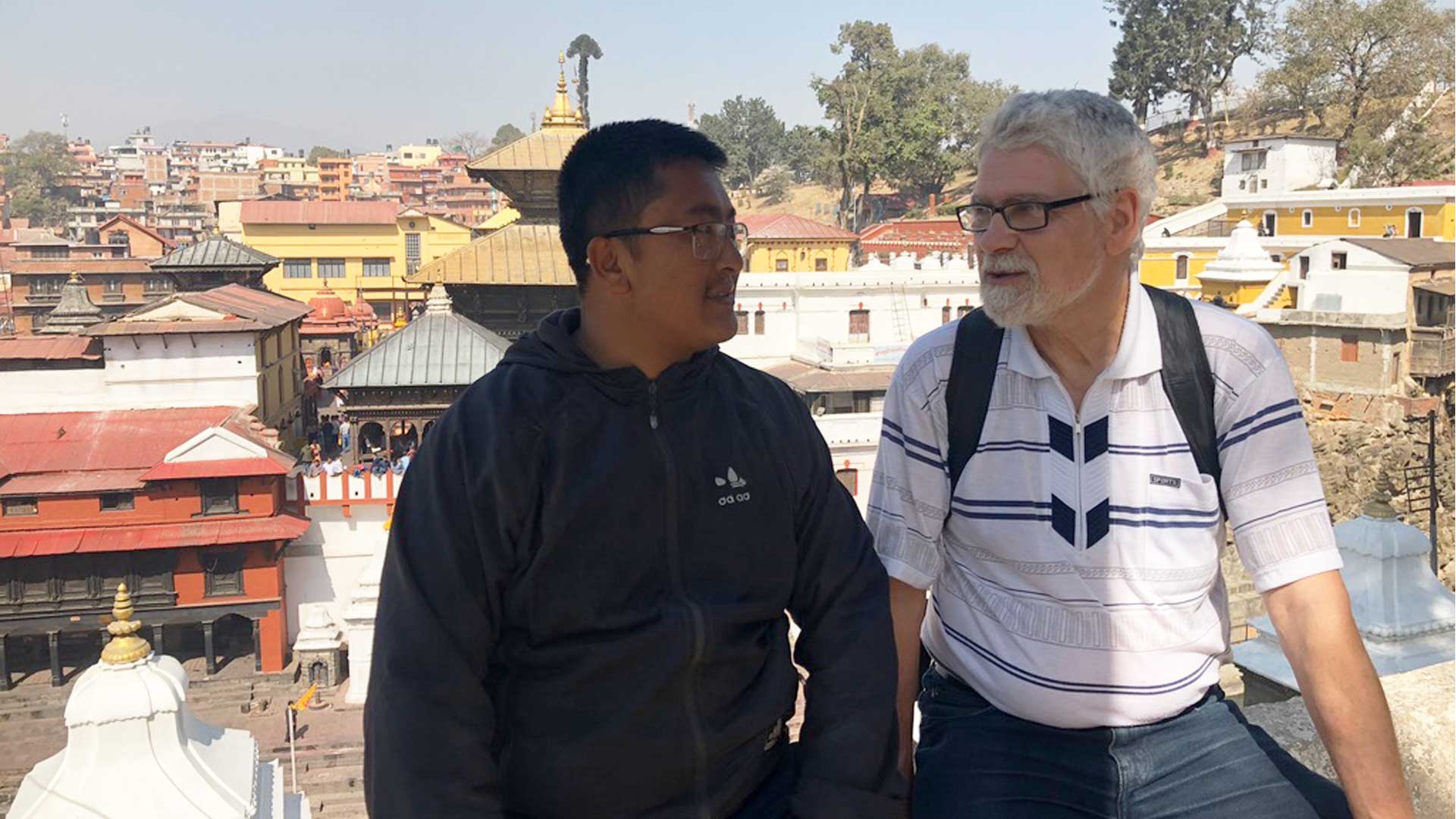
After your first Nepali breakfast, our guide will pick you up from your accommodation and take you on a tour of the Kathmandu Valley, which has multiple UNESCO World Heritage Sites such as the Boudhanath stupa, Pashupathinath temple, Swoyambhunath Stupa, and Kathmandu Durbar Square. After visiting these sights, this day is also used to prepare your backpack for a trek, and if you are missing any important equipment, Thamel is a prime spot to pick it up. Then, at 5 p.m., we will meet you in the lobby of your hotel to go over some essential travel details. If you have any payments due, please pay them during our first meeting. We arrange for you to enjoy a welcome dinner at a cultural restaurant in Thamel, where you may try Nepali cuisine while participating in live cultural programs.
Overnight at Hotel.
Include: Bed and breakfast
Day 3: Drive from Kathmandu to Dharapani (1,960meters) (7-8 hours)
Our guide will receive you up from your hotel early in the morning and drive you from Kathmandu to Beshisahar and then to Syange, which will take approximately 7-8 hours. Today you will encounter tiny communities, their distinct cultures, verdant landscapes, rivers, and magnificent mountain vistas.
Overnight at Hotel
Include: Bed, breakfast, lunch, and dinner, 5 cups of tea or relevant items
Day 4: Trek from Dharapani to Chame (2,650 meters) (6-7 hours)
Your path will take you through rhododendron and alpine forest to Tyanja at 2,360m and then to Kopar at 2,590m. You get the Gurung-specific settlements of Timang for lunch, pass Kodo village and finally Chame (the headquarter of Manang). You get beautiful views of the Marshyangdi River and lovely vegetation, Annapurna II, Tibetan designed houses, and so on.
Overnight at hotel
Include: Bed, breakfast, lunch, and dinner, 5 cups of tea or relevant items
Day 5: Trek from Chame to Pisang (3,300 meters) (5-6 hours)
Your journey begins with a pleasant walk through Telekhu with views of Annapurna and Pisang (6,091m), followed by wooden bridge and a suspension bridge to the south bank of the Marsyandi River, various chortens, Mani walls, and little Gompas. You will travel through a pine and rhododendron forest, an apple orchard at Bhratang, lunch at Dhukur Pokhari after crossing the Marshyangdi River, and then two further more hours to Pisang village for accommodations.
Overnight at hotel
Include: Bed, breakfast, lunch, and dinner, 5 cups of tea or relevant items
Trek 6: Trek from Pisang to Manang (3,570 meters) (5-6 hours)
You will travel directly from Pisang town to lower or upper Pisang. The lower trail is easier than the upper trail. You can travel straight from Lower Pisang or the higher Pisang; if you choose the Upper Pisang trail, then follow the Ghyaru, stopping for lunch at Ngawal before arriving in Manang for lodging. The Upper Pisang trail provides views of Annapurna I, II, III, IV, Gangapurna, Tilicho Peak, Pisang Peak, Chulu East, and many other peaks. However, the Upper Pisang trail has more breathtaking views than the Lower Pisang trail. You arrive in a one-of-a-kind and picturesque Tibetan village, Braga/Bhraka (3,475m), where you will find architectural residences, Gompa, Ngawal village for lunch, and Manang for accommodations.
Overnight at hotel
Include: Bed, breakfast, lunch, and dinner, 5 cups of tea or relevant items
Day 7: Acclimatization Day at Manang (7-8 hours)
Manang is a valley with a distinct local way of life. You climb to Khangsar (3,756m) to acclimate. You set out on a trek to the glacial lake Gangapurna, which was formed by Mt. Gangapurna (7,454 meters), Mt. Annapurna IV (7,525 meters), and others. You visit the village of Manang (3,519 m), pass through a high altitude around 3 p.m., and savor the bakery treats with hot coffee. Manang has a similar view to Ghyar Ngawal village, the oldest and largest settlement in the Nyeshyang Region.
Overnight at hotel
Include: Bed, breakfast, lunch, and dinner, 5 cups of tea or relevant items
Day 8: Trek from Manang to Yak Kharka (4,120 meters) or Churi Leder (4-5 hours)
You're going to Churi Leder of Yak Khark today. It is a short trail. This trail features blue sheep, pheasants, Himalayan pigeons, yak, the domestic goat Chyangra, and many other animals and mountains, including Gangapurna, Tilicho, Thorung Peak, Chulu East and West, Annapurna II, III, and IV, among others. If you're lucky, you might see a rare and endangered snow leopard.
Overnight at hotel
Include: Bed, breakfast, lunch, and dinner, 5 cups of tea or relevant items
Day 9: Trek from Yak Kharka to Base Camp and High camp on Thorong Phedi (4,450m) (4-5 hours)
This is a simple trail day. You slowly walk along the river until you reach the bridge, where you cross to the other bank to reach Thorong Phedi. If you are lucky, you may be able to encounter the famous snow leopard and blue sheep. It is also the residence of Lammergeyer.
Overnight at hotel
Include: Bed, breakfast, lunch, and dinner, 5 cups of tea or relevant items
Day 10: Trek from Thorong Phedi to Muktinath (3,800 meters) via Thorong la Pass or Thorung la Pass (5,416meter) (6-7days)
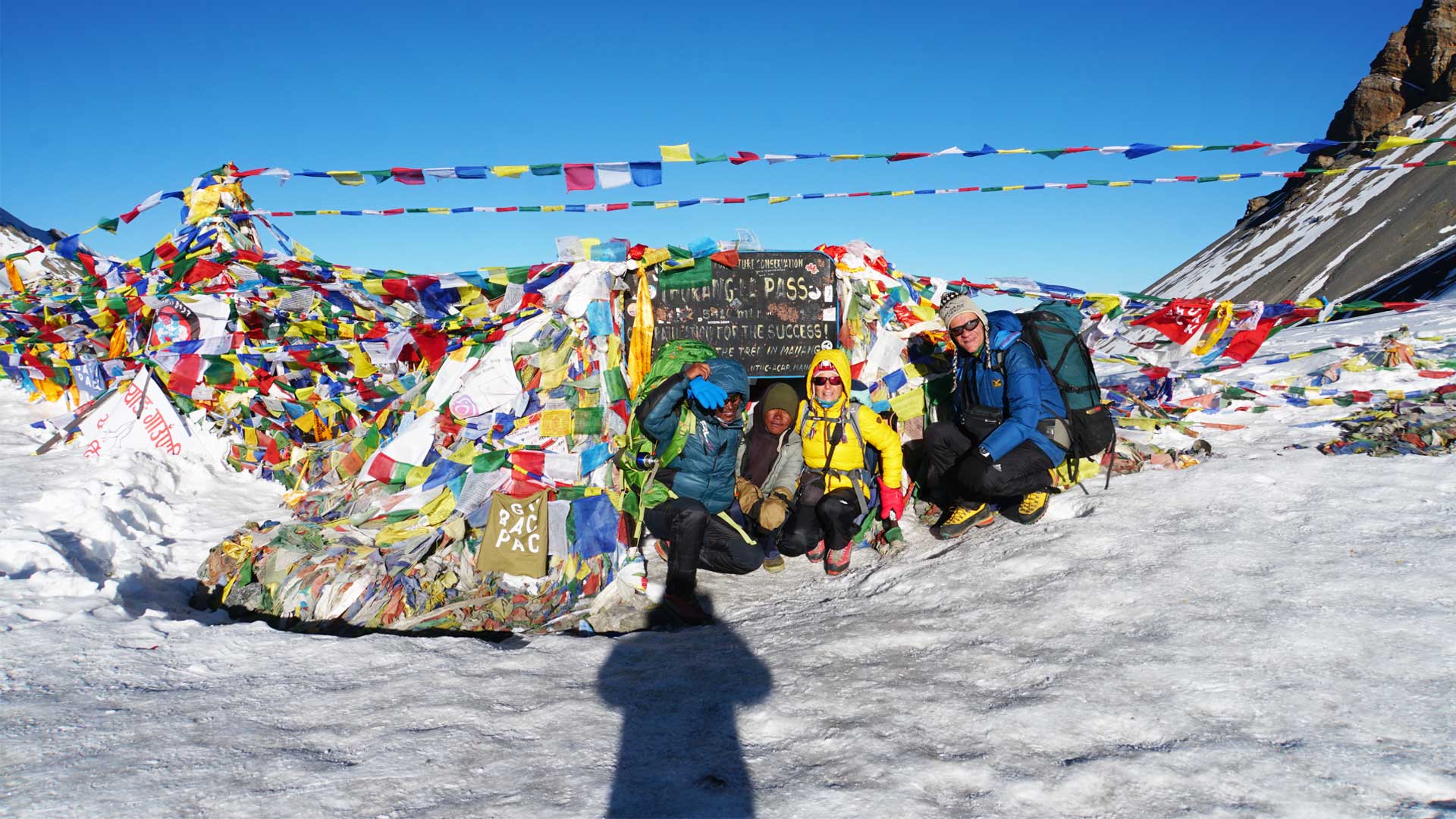
It is the most difficult day of the 14-day itinerary. You ascend a steep trail for about 3-4 hours until you reach Thorung La Pass, where you can see the Bhrikuti peak and numerous other peaks, including Mt. Annapurna, Mt. Dhaulagiri, Nilgiri, Tukuche peak, and several more peaks, including Mustang Valley, merchants, sheep, yak, and so on, before descending to Muktinath. The Muktinath Temple is a Hindu and Buddhist pilgrimage site.
Overnight at hotel
Include: Bed, breakfast, lunch, and dinner, 5 cups of tea or relevant items
Day 11: Trek from Muktinath to Jomsom (2,750m) through Kagbeni (6-7 days)
The route from Muktinath to Kagbeni includes beautiful meadows and forest. You visit Muktinath, have lunch in one of the beautiful villages along the Mustang Kaligandaki River, such as Kagbeni or Akle Bhatti, and spend the night in Jomsom.
Overnight at hotel
Include: Bed, breakfast, lunch, and dinner, 5 cups of tea or relevant items
Day 12: Fly from Jomsom to Pokhara (822 meters) (20 minutes)
On this day, you fly into Pokhara for 20 minutes in the morning before exploring the Pokhara Valley. You explore three of the world's ten highest peaks, including Mt. Dhaulagiri (8,167m), Manaslu (8,163m), Mt. Annapurna I (8,091m), Machhapuchhre (6,993m), Lamjung Himal (6,983m), and many more entire peaks of the Annapurna Region and Dhaulagiri Region. After visiting Davis Falls (Patale Chhango in Nepali), a large limestone cave Mahendra Cave length about 200m, Bat Cave (Chamera Gufa in Nepali), Seti Gandki River/Milk River, the International Mountain Museum, and the Peace/Shanti Stupa, Bindyha Basini Temple, and Barahi Temple, you go boating at Phewa Lake (4.4km square).
Skydiving, paragliding, Seti River rafting, boating in Phewa Lake, Bungee jumping, ultra-light flight, Zip flying, kayaking, and other adventurous activities are available if you are interested.
Overnight at hotel
Include: Bed, breakfast, lunch, and dinner, 5 cups of tea or relevant items
Day 13: Drive from Pokhara to Kathmandu (1,350 meters) (6-7 hours) Or Fly from Pokhara to Kathmandu (30 minutes)
Depending on the route, you can travel to Kathmandu by tourist bus for 7-9 hours or by plane for 30 minutes. It takes 6-7 hours by bus through a beautiful greenery village along the bank of the Trishuli River. A flight allows you to explore the hills, mountains, rivers, and forests, among other things.
Overnight at hotel
Include: Bed, breakfast, lunch, and dinner, 5 cups of tea or relevant items
Day 14: Departure
On the final day, our guide will transport you from the hotel to Tribhuwan International Airport in Kathmandu for your departure.
FREQUENTLY ASKED QUESTIONS
1. Can a beginner/first-time-trekker be able to complete the Annapurna Circuit Trek?
Beginners/first-time-trekker can complete the Annapurna Circuit Trek. You must have trained for 3/4 months for walking, jogging, running, and hiking in order to undertake it comfortably because you will travel for around 6-8 hours each day and enter lower altitudes of 1,000 m to high altitudes of 5,416 m, known as Thorung Pass, during this trek.
2. What physical preparation is needed for Annapurna Circuit Trek?
Every traveler must be physically fit. To enjoy the Annapurna Circuit Trek, you need to be in moderately good physical condition. If you've never walked before, you should walk for 30 minutes every day for at least two months. If there are any problems, our itinerary will be modified.
3. Do we need crampons for Annapurna Circuit Trek?
You usually won't need crampons if you attempt the Annapurna Circuit Trek during the season. You'll really need if you do it during the winter and monsoon months.
4. De we need oxygen bag in Annapurna Circuit Trek?
The Annapurna Circuit Trek path is surrounded by lush, clean scenery. Therefore, an oxygen bag is not required for the Annapurna Circuit Trek. You could have symptoms of high altitude sickness, such as headache, nausea, vomiting, dizziness, exhaustion, loss of appetite, and poor sleep. You shouldn’t worry about any potential issues. You probably experience
5. Do we suffer from high-altitude sickness in Manaslu Circuit Trek?
When you cross over 4,000 meters, mostly people suffer from high altitude. Due to produce of less oxygen and more carbon dioxide ,windy, cause headaches, nausea, tiredness, fatigue, and occasionally vomiting. In these condition, you may suffer temporarily. We follow the some preventive and treatment measures against them. If you may not recover and have a serious illness like a heart condition, headache, or dizziness, we immediately decide against trekking to proceed you would be to descend right away.
6. Is the Annapurna Circuit Trek suitable for individual or single traveler?
The Annapurna Circuit Trek is a challenging high trek that ascends to 5,416m at Thorung La Pass. Individual or solo traveler is possible for Annapurna Circuit Trek, although there is a risk of high trail. As a result, we suggest that you do it with a travel and tour agency to avoid potential challenges with the high route.
7. Is Annapurna Circuit Trek near Kathmandu or Pokhara?
Kathmandu is the beginning and ending of the Annapurna Circuit Trek. From Kathmandu, it takes 5 to 6 hours to reach Beshishahar and Pokhara after arriving at Tribhuwan International Airport in Nepal. The Annapurna Circuit Trek is thus near to Pokhara.
8. What are the people and their way of lives along the Annapurna Circuit Trek Route?
The two main groups in the Annapurna Circuit Trek region are Manangi and Mustangi. Since they were originally from Tibet, they had Tibetan culture. Almost everyone is dependent on business, agriculture, tourism, and hospitality. They are also quite knowledgeable about the trade industry, including Himalayan Viagra Yarsha Gumpa, yak and sheep hurdles, and other Chinese and Tibetan items. In the past, people's lives were incredibly difficult. Because of their geographic location, they were dependent on Tibet for everything, but today they have access to roads from Kathmandu and import commodities on a regular basis from Pokhara and Kathmandu.
9. What altitude is reachable for the Annapurna Circuit Trek?
This journey of Annapurna Circuit Trek starts at an elevation of 1,900 meters in Dharapani and Pass at an elevation of 5,416 meters at the snow line, one of the highest vistas, Thorung-La Pass, and then finishes at an elevation of 2,743 meters in Jomsom in Mustang.
10. Is Annapurna Circuit Trek for beginners?
Physical acclimatization is challenging for beginners in Annapurna Circuit Trek. It is possible for beginners to complete the trek with your well preparation and precaution. So trekkers should prepare for the altitude to prevent altitude sickness. They should train well in advance for at least two months in hiking, walking, or jogging for this trek. Trekkers should begin with regular exercise.
